Synthetic Benchmarks
We'll wrap up our performance benchmarking with a couple of less important metrics. Futuremark has been making 3DMark for over six years, and many people refer to it to see how a system will perform in games. We have always preferred real world gaming benchmarks, though it's difficult to come up with repeatable tests for certain genres. We also included the memory latency, as measured by CPU-Z.
Going along with that last point, take a look at the memory latencies. Since both chips are running at 2.4 GHz, we can directly compare the results without converting to nanoseconds. The HP system with its CL3 RAM ends up having 28% higher latencies, which explains why it consistently gets beat by the ASUS system with the slightly slower processor. Also somewhat interesting is that the IGP solutions both have higher memory latencies, showing that the shared memory architecture does have an impact on performance.
We'll wrap up our performance benchmarking with a couple of less important metrics. Futuremark has been making 3DMark for over six years, and many people refer to it to see how a system will perform in games. We have always preferred real world gaming benchmarks, though it's difficult to come up with repeatable tests for certain genres. We also included the memory latency, as measured by CPU-Z.
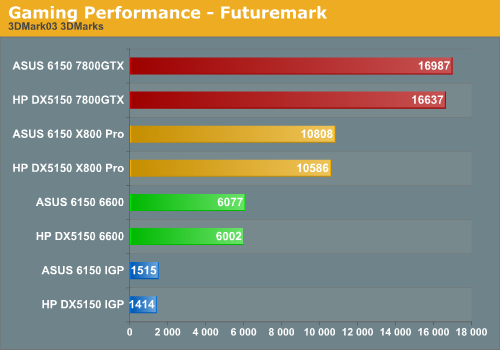
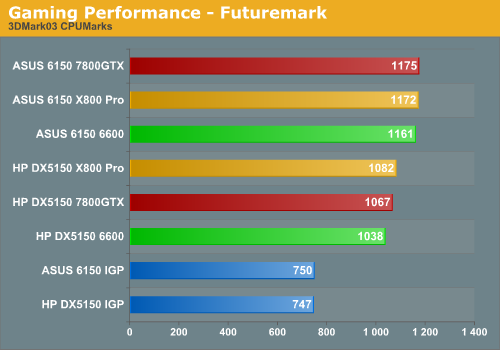
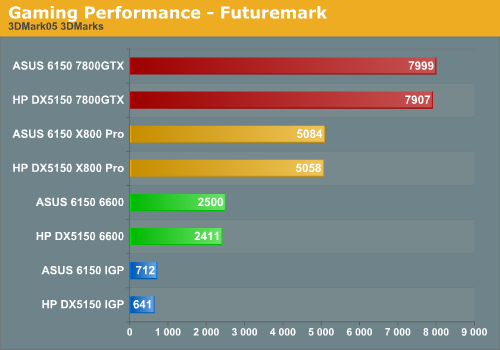
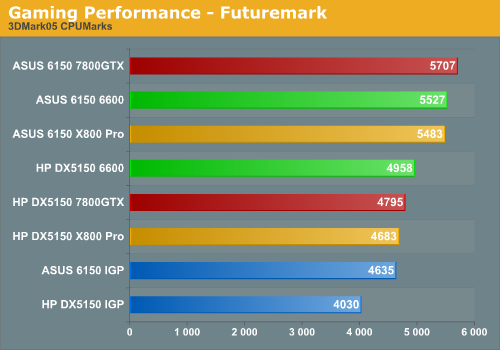
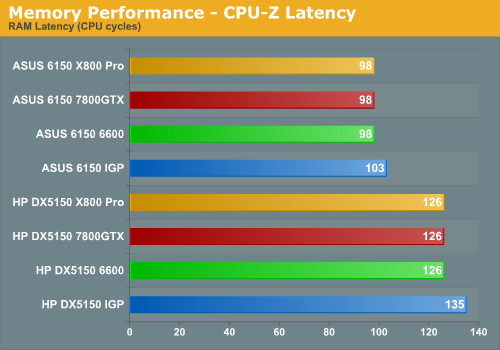
Going along with that last point, take a look at the memory latencies. Since both chips are running at 2.4 GHz, we can directly compare the results without converting to nanoseconds. The HP system with its CL3 RAM ends up having 28% higher latencies, which explains why it consistently gets beat by the ASUS system with the slightly slower processor. Also somewhat interesting is that the IGP solutions both have higher memory latencies, showing that the shared memory architecture does have an impact on performance.










48 Comments
View All Comments
JarredWalton - Thursday, December 15, 2005 - link
I was waiting for someone to ask that. :-)Honestly, I threw them in for home users that might want to purchase such a system. For businesses, they mean nothing. Still, to a certain extent, benchmarks are benchmarks; many of the gaming tests are impacted by the GPU used, but if a system like this can handle high end game, it can certainly handle running Photoshop, Word, Excel, Internet Explorer, and all the other typical office applications.
Ditiris - Thursday, December 15, 2005 - link
I work for a small defense company (I fell/was forced into the IT position) and purchased ten of these systems for our new classified LAN where most of the work will be compute intensive applications (MATLAB simulations, for instance). I have, up until this time purhcased Dell systems because pricing on AMD systems from other OEMs was too high to justify the performance gains over the Intel systems from Dell.It was nice to see your article follow the same line of reasoning that I did Jarred. I would be very interested in similar articles in the future, from the perspective of the small to medium business needs.
For those saying there isn't an X2 core, I can verify that indeed they do have an X2 core. I got all my systems shipped with X2 3800+ cores. I don't know if the sku numbers are right, but you can definitely get the system with an X2 core.
For the caution, the first system, which I purchased as a test system, arrived in less than a week. After testing the system with all our software and making sure there were no WinXP 64 compatibility issues, I ordered nine more on 11/23 which took until 12/14 to arrive.
I received an automatic notice from HP that there was a delay in fulfilling my order after a week and that the original ship date on my order confirmation would be, well, delayed. Since there wasn't an estimated ship date on my order confirmation, nor a new ship date on the delay notification, I can say HP's order estimation needs some work. Fortunately, this wasn't an issue for me.
I ordered the sort of bargain configuration with 160 GB drive, CD-ROM, 512 MB RAM. Because of security requirements, we are required to remove the hard drives and put them in caddies. So, I separately purchased DVD-R/W's and 4 GB of RAM for each machine. If we're taking apart the systems anyway I'm not paying 300% markup for those parts.
For what it's worth, I'm extremely satisfied with the test box I've been using for three weeks. But, you might want to talk to a CSR to see what the wait time will be if you need the systems fast.
AstroCreep - Thursday, December 15, 2005 - link
Yeah, my company has bought a few of them too. Great little systems!We've been purchasing HP (and Compaq before them) for a few years now and have been pretty happy with the quality & service (better than the Gateways we used to buy before I worked here).
We've been getting the $600 system which consists of an Athlon64 3200+, 80GB HDD, 512GB RAM. For our needs, they work wonderfully; sure we might consider something different for our CAD guys and graphic-artists, but for the rest of our users who are more or less just 'Office' people, they're great!
I can also attest to the shipping issues of HP-Direct. We have an account with them and for the last few years we bought direct. This past year however has changed my opinion - by June three of our six orders I placed direct were delayed beyond the quoted date (which was always about a week after the order was placed to begin with), so now I generally go through CDW, PC Mall, Insight, etc. Besides, HP is changing their business focus and are placing greater emphasis on selling through reseller channels versus direct. Will obviously still be an option though. ;)
OrSin - Thursday, December 15, 2005 - link
One other thing I'm sick or people stating. Amd could not uspply all the OEMs. Of course not, becuase right now they do need to. Who the hell is goig to have the capacity to supply 5 time what is in demand. If more OEM use them they will ramp up just like every other company in the world. AMD have not had a supply problem in 4 years. Intel has had chipset supply and processor supply problems off and on for the last 3 years, but no one says let stop buying intel they can't supply us stuff. I know its not all OEM problesm since most of the buying managers are old farts, that still be believe IBM is the greatest company on earth. So you see how far behind the times they are.johnsonx - Thursday, December 15, 2005 - link
it's the same old thing: no one ever got fired for buying Intel (formerly IBM). If you're an IT manager for a company, why buy AMD? If you buy Intel, and some odd problem comes up, no one will blame you (after all, Intel is THE standard). If you buy AMD, and some problem comes up, well good luck finding another job. Sure, it isn't likely, but why bother with it in the first place?JarredWalton - Thursday, December 15, 2005 - link
You also have to remember that even when Intel has had supply problems, those are mostly for the retail market. Big OEMs get first priority, and the bigger you are the higher your priority. Business OEM chips are almost never in short supply from Intel. It's the high-end "exotic" parts that are sometimes more difficult to buy, but the starndard SIPP components are almost always in abundance.OrSin - Thursday, December 15, 2005 - link
What really getting me about all the OEM is the way they just disrespect AMD systems.HP's catalog does list a since AMD system. But if you talk to them in person or go on line they push how great thier AMD systems are if you bring it up. ITs like AMD is an after thought for them. But hwta really pisses me off is the way HP had push thier low cost amd systems for the Black friday sales, then all of sudden they will not sell them any more. It stays out stock on thier site. It really mean we perfer to sell intel only we only have amd to get people to look at us.
Furen - Thursday, December 15, 2005 - link
Power supplies are rated on their output current, not their input current. If you are measuring the power draw at the plug (before the power supply) then your power draw will be quite a bit higher than what the system is actually drawing (Seasonics achieve ~85% efficiency and I doubt these PSUs are comparable to those).I would guess the efficiency of that PSU is around 80% TOPS (that's a great efficiency, since most PSUs out there struggle to hit even 75%) which would mean that your power draw is actually ~180W using a 7800GTX (225 * 0.8), which means that you should have quite a bit of juice still left (if the PSU can actually achieve a 210 or so on the 12v rail, having 70W or so on the 5v line doesn't really help).
JarredWalton - Thursday, December 15, 2005 - link
That's true, but wall power is a lot easier to measure. :-)PrinceGaz - Friday, December 16, 2005 - link
I think he's referring to this bit you wrote:"... but even in the worst-case scenario (i.e. using a 7800 GTX), power draw never reached above 225 Watts. You would still have enough room to add a second hard drive, assuming that the power supply can sustain 250 Watts."
That situation when the INPUT power was 225 watts most probably meant that the OUTPUT power from the PSU was likely to be no more than 180 watts. That is a full 70 watts under the 250 watts the PSU is rated at, whereas you suggest there was only 25 watts to spare. But a very good review overall, Jarred.